Paged Media
Prince produces PDFs - which are a prominent example of paged media. There are a few points that are crucial to keep in mind when preparing a document for paged media, specially if intended for print:
- Pagination
The major difference between formatting for the web and for PDF/Print is that PDF is paginated, i.e. the content is placed on discrete pages. Pages have a defined size and content can be laid out in a specific pattern making use of predefined page regions. Elements can not only be floated right and left, but they can also be floated to the top and bottom of the page, or of a column, or the float even can be deferred to the next page (see Prince extensions to floats). Pages can be selected and named, which allows for specific treatment of certain pages. Also, it is important to have an understanding of pagination: content might not fit on a page and might spill over into the next page, or it might be necessary to move it to the next page in order to avoid creating gaps (see also Conditional modifiers).
- Page spreads
A basic unit for paged media in print is the page spread: the left page, called verso in a left-to-right script (see Writing Mode), and the right page, called recto, are of the same size and typically are symmetrical to each other and are centered on the gutter. Selected and named pages can be placed recto or verso, and Prince expands several properties and the
@pageat-rule pseudo-classes with the valuesversoandrecto, orinsideandoutside, referring to the layout on each page of the spread.- Non-interactive
Last but not least, paged media intended for print is non-interactive by nature. All CSS properties referring to user interaction make no sense, scripting cannot be interactive and scripts need to run before layout is finished. But for these details and scripting after layout please check the section on JavaScript in Printed Media.
Prince allows you to control a number of options that affect how to format pages, from straight-forward options such as page size, to page style, page regions like headers and footers, pagination control and page numbering.
CSS properties that affect pages are specified within page at-rules (see CSS At-rules). For example, we can use the size property within the @page rule to specify the page size (see Page size).
@page {
size: A4
}
In this section we will show most of the properties that can be specified within a page rule, then we will show how pagination can be controlled and how page styles can be applied to selected pages.
The initial values for CSS properties are defined internally - these are the initial @page styles:
@page {
margin: 54pt;
-prince-bleed: auto /* '6pt' if marks present */ ;
-prince-trim: auto /* '57pt 48pt' if marks present */ ;
marks: none;
-prince-mark-length: 24pt;
-prince-mark-width: 0.1pt;
-prince-mark-offset: auto /* equal to prince-bleed */ ;
size: Letter;
-prince-pdf-page-colorspace: auto;
-prince-pdf-page-label: auto;
-prince-rotate-body: 0deg;
-prince-shrink-to-fit: none;
}
Page size
Page size can be specified using the size property in length units or by a page size keyword (see Page Size Keywords for a list), optionally combined with the portrait or landscape keyword.
/* Use A4 paper */
@page { size: A4 }
/* Use A4 paper in landscape orientation */
@page { size: A4 landscape }
/* These two custom sizes are equivalent */
@page { size: 30cm 40cm }
@page { size: 40cm 30cm landscape }
/* Use square paper, this sets width and height */
@page { size: 30cm }
Sometimes it can be useful to specify the page dimensions in pixels, for example when creating presentation slides (see the Presentation slides example).
@page {
size: 1280px 960px;
}
Page style
Pages, like other block level elements, follow the CSS box model introduced in Box Model. Their margin, border, padding and background can be styled within @page rules.
The @page rules can only style the page and its margin boxes - it cannot contain style rules to target specific elements, but it can contain at-rules to target the page regions (for a complete list of possible at-rules, see Page regions).
@page {
margin: 2cm;
}
Prince also supports the margin-outside and margin-inside properties. These allow you to specify different margins for the inside and outside edges of paper as it is bound into a book. For example it may be necessary to have a larger inside margin (called a gutter) so that after some of the margin is used by the binding, the remaining margins are even.
@page {
margin: 2cm;
margin-inside: 3cm;
}
This is used in Fancy headers.
Page regions
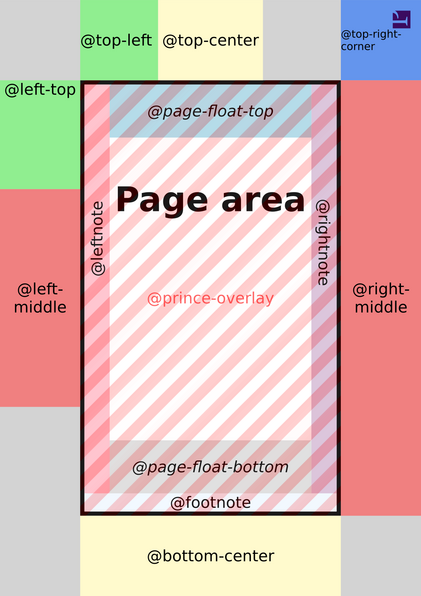
Most content appears inside the page area of one or more pages - in the above figure the page area is marked with a solid black border. Surrounding the page area is the margin area, defined by the margins set with @page rules, which contains the page-margin boxes. Other special areas, i.e. the page area regions, are overlaying the page area, or are placed at its left, or right side, or at its top, or bottom. Collectively, they are known as the page regions.
The figure above shows the position of some page-margin boxes, which can be used for creating running page headers and footers, as well as some common regions in the main page area.
The @page background is lightgrey and the body's, i.e. the page area's background, is white.
@page {
background-color: lightgrey;
}
body {
background-color: white;
}
You can place content in a page-margin box with the content property - the areas inside the page area, however, do not take generated content. You can thus print the current page number at the bottom of each page (see Generated Content):
@page {
@bottom-center {
content: counter(page);
}
}
Two examples in the next chapter show examples of page headers and footers:
- the Novel title page example creates a footer to display the page number, but suppresses it for the title page; and
- the Textbook page numbers example displays a more complex use of headers by placing the book title in the header of left pages, and the current chapter's title in the header of right-facing pages, in addition to the page number.
The full list of page regions is shown in the following Page regions table.
Page regions
| Name | Default alignment | In figure | ||
|---|---|---|---|---|
text-align |
vertical-align |
|||
| Page area | start | baseline | solid black border | |
| Page-margin boxes | @top-left |
left | middle | lightgreen |
@top-center |
center | middle | lemonchiffon | |
@top-right |
right | middle | not shown | |
@bottom-left |
left | middle | not shown | |
@bottom-center |
center | middle | lemonchiffon | |
@bottom-right |
right | middle | not shown | |
@left-top |
center | top | lightgreen | |
@left-middle |
center | middle | lightcoral | |
@left-bottom |
center | bottom | not shown | |
@right-top |
center | top | not shown | |
@right-middle |
center | middle | lightcoral | |
@right-bottom |
center | bottom | not shown | |
@top-left-corner |
right | middle | not shown | |
@top-right-corner |
left | middle | cornflowerblue | |
@bottom-left-corner |
right | middle | not shown | |
@bottom-right-corner |
left | middle | not shown | |
| Page area regions | @page-float-top |
center | top | lightblue |
@page-float-bottom |
center | bottom | gainsboro | |
@leftnote |
left | middle | pink | |
@rightnote |
left | middle | thistle | |
@outsidenote |
left | middle | not shown | |
@insidenote |
left | middle | not shown | |
@footnote |
left | middle | aliceblue | |
@prince-overlay |
center | middle | stripes | |
- Page-margin boxes
Prince will try to create page-margin boxes of the correct sizes. If you need to create boxes of specific sizes you may need to use only a single box (eg:
@top-center) and use thecontentproperty to place elements with specific sizes in it.In the above Page regions figure, Prince leaves space for
@top-rightand@left-bottomboxes because their counterparts (@top-leftand@left-toprespectively) have been defined. This keeps the@top-centerand@left-middlecentered along the top and side of the page respectively.These page regions, however, only subdivide the space within the page body width, and height, none of them extend into the corners. To target a corner region, the areas ending in
-cornerneed to be used.The page-margin boxes
@top-center,@top-leftor@top-rightcan be used to create running page headers, and the page-margin boxes@bottom-center,@bottom-leftor@bottom-rightare useful for page footers (see Page Headers and Footers).- Page area regions
The page area itself has a few special regions that can be addressed with specific at-rules: to the left and right are two sidenote regions (
@leftnoteand@rightnote), and at the top and bottom of the remaining space are two more regions (@page-float-topand@page-float-bottom). Below all these, there is the footnote area.Note that a padding expressed on the page area lies outside of the page area regions - with the exception of
@prince-overlay.The page region
@prince-overlayis a special region, overlaying all of the page area, including any padding. A typical use is for creating watermarks on all pages of the document (see Watermarks).The page region
@footnoteis placed by default at the foot of the page area and contains the footnotes (see Footnotes).If there are no footnotes on a page, or if the footnote elements are empty, the footnote area will not be displayed on that page at all.
The regions
@page-float-topand@page-float-bottomare also not displayed at all, if no elements exist for them, but, as opposed to the footnote area, they are displayed if an element exists, but is without content, i.e. an empty element.The
@footnotearea can be positioned other than its default position (see Styling and behavior of footnotes). All other page regions cannot be moved - their position is defined by the page margins, or their position in the page area.The
@leftnoteand@rightnoteareas for sidenotes are placed left and right of the page area and contain the sidenotes (see Sidenotes). For page spreads, there are also at-rules for@outsidenoteand@insidenote. The sidenote areas need a width to be defined.
Many CSS properties can be applied to page regions:
The height of the top and bottom page-margin boxes, as well as the width of the left and right page-margin boxes is defined by the
marginvalues of the page style given in a@pagerule (see Page style for more details).All of the
margin,border,paddingandbackgroundproperties can be used to style page regions.The
vertical-alignproperty can be applied to any page region to vertically align its content.When a page region contains generated content, many inline style properties such as
colorandfontcan be applied to style the generated content.
Generated content in page regions
As mentioned, page-margin boxes can be populated with generated content with the content property, but the page area regions do not allow for generated content.
We have also seen how to print the page number at the bottom of each page with the page counter.
@page {
@bottom-center {
content: counter(page);
}
}
The page counter is predefined and starts at 1; it increments automatically for each new page. (Note that the page counter cannot be incremented manually using the counter-increment property.)
The page counter can be reset using the counter-reset property at any block-level element within a non-floating element in the normal flow. This is useful for restarting page numbering at a new section of the document.
Restarting page numbering
HTML
<body>
<div class="front"> cover page, etc, ... </div>
<div class="contents">
table of contents, ...
</div>
<div class="body">
<div class="chapter"> chapter 1...</div>
<div class="chapter"> chapter 2...</div>
</div>
<div class="appendix"> appendix1 </div>
<div class="appendix"> appendix2, ... </div>
</body>
CSS
.contents {
display: block;
page: table-of-contents;
counter-reset: page 1
}
@page table-of-contents {
@top-center {
content: "Table of Contents"
}
@bottom-center {
content: counter(page, lower-alpha)
}
}
.body {
display: block;
page: main;
counter-reset: page 1
}
@page main {
@top-center {
content: string(chapter-title)
}
@bottom-center {
content: counter(page)
}
}
.chapter h1 {
string-set: chapter-title content()
}
This example also uses Named pages which we will explain in more detail below. We create three types of pages: table-of-contents pages, main pages, and pages without a name.
The .contents rule names the pages that it appears on as table-of-contents and resets the page counter to 1 at the start of the contents div. Then the @page rule for those pages generates a page footer that contains the current page number in lower-alpha style. This rule also sets the page header to the string "Table of Contents".
The .body rule names the pages that it appears on as main and resets the page counter to 1 at the start of main div. Then the @page rule for the main pages generates a page footer that contains the current page number in the default decimal style. This rule, together with the .chapter h1 rule, sets the page header to the title of the chapter.
Pages that don't match either of these names have the default style, which does not include a page number in the footer.
In some documents, particularly those that are unbound such as office documents, it can be useful to show the total number of pages on each page. The total number of pages can be accessed using the pages counter. This is a pre-defined counter that is fixed to the total number of pages in the document.
@page {
@bottom-center {
content: "Page " counter(page) " of " counter(pages)
}
}
This rule will generate page footers such as "Page 1 of 89".
Fancy header example
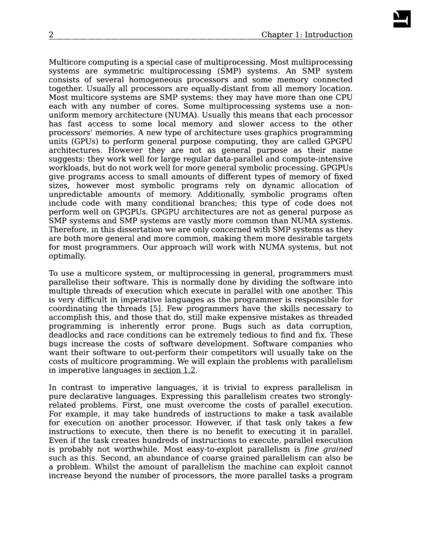 This example shows a header as might be found in a textbook. The HTML and PDF are both available. This is a small part of a larger example in our Prince samples repository.
This example shows a header as might be found in a textbook. The HTML and PDF are both available. This is a small part of a larger example in our Prince samples repository.
Fancy headers
This example demonstrates a more complete headers style. It uses generated content to print page numbers, the chapter number and title and the section number and title using different styles for left and right pages. It also prints an underline under the header.
@page {
font-family: Times, Serif;
font-size: 11pt;
text-align: justify;
margin-top: 2cm;
margin-bottom: 2cm;
margin-inside: 3.5cm;
margin-outside: 2.5cm;
}
@page body:left {
@top-left {
content: counter(page);
vertical-align: bottom;
}
@top-right {
content: "Chapter " counter(chapter) ": " string(chapter);
vertical-align: bottom;
}
}
@page body:right {
@top-right {
content: counter(page);
vertical-align: bottom;
}
@top-left {
content: counter(chapter) "." counter(section) " "
string(section);
vertical-align: bottom;
}
}
@page body {
border-top: thin black solid;
}
@page body:first {
margin-top: 25%;
@top-left { content: normal; }
@top-right { content: normal; }
border: none;
}
@page body:blank {
@top-left { content: normal; }
@top-right { content: normal; }
border: none;
}
body {
font-family: Times, Serif;
font-size: 11pt;
text-align: justify;
padding: 0.5cm 0cm;
}
div.body {
page: body;
}
div.body h1 {
break-before: right;
-prince-page-group: start;
string-set: chapter content();
counter-increment: chapter;
counter-reset: section;
}
div.body h1::before {
content: "Chapter " counter(chapter) ": ";
}
div.body h2 {
string-set: section content();
counter-increment: section;
}
div.body h2::before {
content: counter(chapter) "." counter(section) " ";
}
The main content area is 2.5cm from the page's edge on all sides. On the left and right this is a margin of 2.5cm and on the top and bottom it's 2cm of margin and 0.5cm of padding. This places the bottom border of the @top page region 0.5cm from the main content area, enough to avoid making it look crowded. The header text has the vertical-align: bottom property to ensure that it appears immediately above the border — the border is made to look like an underline. This example uses many properties and page selectors discussed later in this section. This is a small part of a larger example in our Prince samples repository.
Content can also be copied, or removed from the normal document flow, to place it into the page regions - in the former case, it will receive new styling specific to the page region, in the latter case it will mostly inherit the style of the original location, as described in the following sections.
Copying content from the document
Generated content in page regions may contain text content copied from the document using the string-set property:
CSS
@page {
@top-center {
content: string(doctitle)
}
}
h1 { string-set: doctitle content() }
The @page rule specifies that the top-center page region will contain the text content of the document title copied from the text content of the h1 element in the document.
The second argument to the string() function is a page-policy (see The optional page-policy value).
For a dictionary, you might want to have a page header that says "a-af", where "a" is the first definition on the page and "af" is the last, so you apply string-set for each definition, and then you can select the first and last one with a page policy in the page header.
@page {
@top-left { content: string(term, first);}
@top-right { content: string(term, last);}
}
The page policy value first-except is equivalent to start, unless the string-set is applied on the current page, in which case it will return no value.
This can be very useful as a means to repeating the title of a chapter as a page heading in the @top-center page region, without duplicating the information on the page where the heading appears in the running text of the page.
@page {
@top-center { content: string(letter, first-except);}
}
You can see these examples in full action in the Dictionary sample (HTML - PDF).
Taking elements from the document
Page region content may also be taken from the document itself. Any block-level element can be removed from the normal flow and placed in a page region. It will normally inherit styling from its original position in the document, but does not display there. Please also note the following:
- All
marginproperties of an element not in the natural document flow will be ignored. - The first running element that appears on a page will be used on the current page and carried onto following pages, until a new running element is encountered.
To move the content into a page region, the element needs to be removed from the normal document flow position with the running() function of the position property, and inserted into the specified region with the element() function of the content property.
CSS
@page {
@top-center { content: element(header) }
}
h1 { position: running(header) }
The @page rule specifies that the top page region is a new running header named "header".
The rule for the h1 element moves it to the "header" running element, removing it from the default normal flow.
Prince also provides another interface for creating running headers: the content can be removed from the normal flow with -prince-flow: static(), to be placed in a page region with content: flow().
CSS
@page {
@bottom-center { content: flow(footer) }
}
footer { -prince-flow: static(footer, start) }
In addition to the standard mechanism, the Prince specific one offers an extra feature that might be useful in certain scenarios: the static() function accepts an optional start argument, which makes the fetched content available, as if it were fetched from the start of the document. An example to clarify:
Many HTML documents designed for browsers have the following structure:
<header>
main content
<footer>
Unfortunately, if you want to place the footer element in the page footer, it will only appear on the last page - because it is at the end of the document! To solve this, the document must be modified to look like this:
<header>
<footer>
main content
It can be achieved by using JavaScript to move the element, but the simple start keyword on the -prince-flow property instructs Prince to pretend that the element was seen at the beginning of the document.
The element() and flow() functions replace the entire margin box, and cannot be combined with other content. If you just want to capture some text from the document, use named strings instead (see Copying content from the document) - they can be combined with other content.
Selecting pages
It is often necessary to apply styles to some pages, but not others. Either applying them to only some pages, or on every page except selected pages. CSS and Prince provide a number of page selectors for choosing which pages a rule applies to.
In a novel it is useful to print a page number at the bottom of every page, except for some pages such as the title page. In this example the @page rule is applied to all pages. Then the @page:first rule, which is more specific, removes the footer from the first page. See Page regions and Generated Content.
Novel title page example
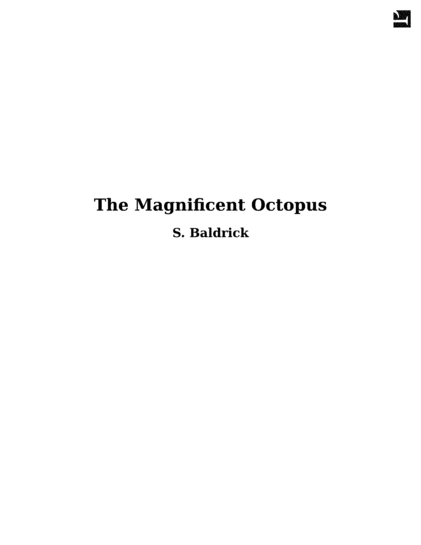 A title page example showing use of
A title page example showing use of @page:first. Download the PDF or the HTML.
<html>
<head>
<style>
@page {
@bottom-center {
content: counter(page)
}
}
@page:first {
margin-top: 10cm;
@bottom-center {
content: normal
}
}
h1, h2.subtitle {
text-align: center
}
h2.chaptertitle {
break-before: page
}
</style>
</head>
<body>
<h1>The Magnificent Octopus</h1>
<h2 class="subtitle">S. Baldrick</h2>
<h2 class="chaptertitle">Chapter 1</h2>
<p>Once upon a time there lived a little saussage.</p>
</body>
</html>
In this example the @page rule specifies styles that apply to all pages: Then the @page:first rule overrides this for the first page only. It resets the content property for the footer and increases the top margin, printing the title of the novel in a reasonable place on the page (see Page style). This example also uses the break-before property to force a page break (see Page breaks).
When using the :first page selector to choose the first page in each chapter (such as in Fancy headers) it may be necessary to add -prince-page-group: start to the first element in each chapter (such as h1). See Page groups.
The :left and :right page selectors can be used to style left and right pages in a bound book differently. This is often used in text books to place the page number on the outside top corners of pages.
Alternatively, the :recto and :verso selectors can be used, with the advantage of being independent of directionality of the script: in a left-to-right script, :recto is the right-hand side of a spread, and :verso is the left-hand side, while in a right-to-left script these values are inverted: :recto defines the left-hand side of a spread, and :verso defines the right-hand side. See also Writing Mode.
Textbook page numbers example
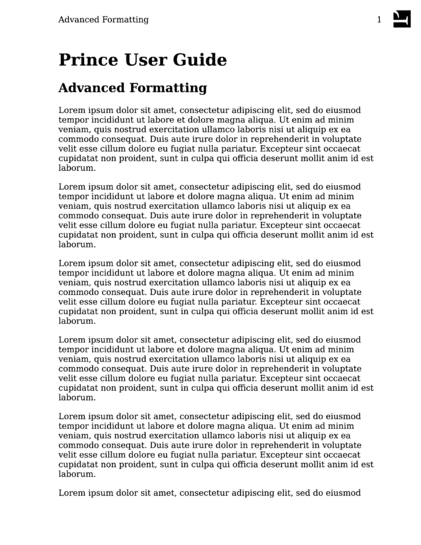 A text book example showing use of
A text book example showing use of @page:left and @page:right. Download the PDF or the HTML.
@page:left {
@top-left { content: counter(page) }
@top-right { content: string(book-title) }
margin-left: 2cm;
margin-right: 3cm;
}
@page:right {
@top-left { content: string(chapter-title) }
@top-right { content: counter(page) }
margin-left: 3cm;
margin-right: 2cm;
}
h1 { string-set: book-title content() }
h2 { string-set: chapter-title content() }
These rules also place the book title in the header of left pages, and the current chapter's title in the header of right-facing pages. The book title is copied from the text content of the h1 element while the chapter title is copied from the text content of the h2 elements (see Generated Content). They also specify wider margins in the gutter of the page spread; binders may need this extra width for a book's binding.
The first page in a document using the default left-to-right reading order is a right page. Imagine the cover or a title page of a book which appear on a right page. The first page of a right-to-left document is a left page.
By putting break-before: left or right at the very beginning of the document, it will not leave a blank page, but instead will change whether the document begins on a left or right facing page.
Sometimes it can be useful to select the Nth page in a document. The :nth(N) page selector can be used to do this:
@page:nth(42) {
...
}
Named pages
Sometimes it is necessary to style pages depending on their content; named pages allow us to select pages that contain particular elements. We used this in Restarting page numbering, to apply a style to the table of contents pages to print their page numbers using roman numerals.
The element containing the table of contents has a page property applied, specifying that this element's pages are table-of-contents pages. The page property may be applied to any block-level element within a non-floating environment in the normal flow.
.contents {
display: block;
page: table-of-contents;
}
Then using this page name to apply a different @page rule to the table-of-contents pages:
@page table-of-contents {
@top-center { content: "Table of Contents" }
@bottom-center {
content: counter(page, lower-alpha)
}
}
More than one element can belong to the same name, in other words, page names behave like CSS classes.
Prince will create a page break between elements belonging to different named pages, including elements without a named page. So in Restarting page numbering, a page break will be inserted after the the table of contents, because the next element has the page name main rather than table-of-contents.
Selectors such as :first, :Nth, :left and :right also work with named pages. For example:
@page preface {
@bottom-center {
content: counter(page, lower-alpha)
}
}
@page preface:first {
@bottom-center {
content: normal;
}
}
This example only works when a page name is used only once within a document, such as for the preface of a document (documents only have one preface). If you wish to apply a style to the first page of every chapter then you must use the -prince-page-group property to create page groups:
div.chapter {
page: chapter;
break-before: right;
-prince-page-group: start;
}
@page chapter {
@bottom-center {
content: counter(page);
}
}
@page chapter:first {
@bottom-center {
content: normal;
}
}
The property -prince-page-group: start instructs Prince to start a new page group. This is necessary for the div.chapter:first selector to match the first page of each chapter, instead of only the first page in the first chapter. See Page groups.
Blank pages
A special case are blank pages.
As we discussed in the previous section, break-before: right can be used to place the first page of a chapter on the right page in a spread. If the previous page is a right page, two page breaks are inserted, leaving a blank left page. However, this page will have normal @page styles applied to it, which is usually not what people want. The :blank page selector can be used to change the style of blank pages, pages skipped such as a left page before a break-before: right, including removing any content.
@page:left {
@top-left {
content: counter(page);
}
}
@page:right {
@top-right {
content: counter(page);
}
}
@page:blank {
@top-left {
content: normal;
}
@top-right {
content: normal;
}
}
h1 {
break-before: right;
}
This example clears the generated content used on these pages. This works because :blank is more specific than either :left or :right. The :blank page selector can also be used with named pages.
@page frontmatter {
@bottom-center { content: counter(page, lower-roman); }
}
@page frontmatter:blank {
@bottom-center { content: normal; }
}
If chapter 1 also resets page numbering, then the page numbers will be reset on the first content page, i.e. a non-blank page.
It is not always desirable to have no content on blank pages. Sometimes otherwise blank pages are required have some content, such as a notice saying "This page intentionally left blank". For example, in legal documents, this prevents people from mistaking a dangerous printing error for an intentionally blank page.
Page groups
When consecutive elements belong to the same named page but logically separate structures (such as individual chapters) Prince combines them into one page group. This causes it to apply the :first page selector to the first page of the whole page group only (the first page of chapter 1). Instead we usually want :first applied to the first page of each chapter.
This can happen either:
- when chapters are separated by an element, such as
h1which may havebreak-before: rightapplied (this can be seen in Fancy headers); - or when each chapter is a block element such as a
div.
Prince provides the -prince-page-group property that can be used to start a new page group. It can be seen in Fancy headers applied to h1 elements in the body of the document.
div.body h1 {
break-before: right;
-prince-page-group: start;
...
}
-prince-page-group also forces a page break, overriding any properties that attempt to avoid page breaks. The more specific left and right page take precedence over -prince-page-group.
Controlling pagination
Prince will create page breaks automatically when new content will not fit on a page. Sometimes it is useful or necessary to control where page breaks should and should not be used. There are two ways to do this, and both are useful in different circumstances: page breaks can be added or prohibited with the Page breaks properties, and you can control where, within a paragraph, a page break may occur with the Widows and orphans properties.
Page breaks
The simplest case is when you want to explicitly create a page break. This is typically used at the beginning of a chapter, to start the new chapter on a new page.
h1 {
break-before: page;
}
The property break-before is used to force a page break immediately before an h1 element. New chapters are often started on the recto pages in text books, this is usually the right page:
h1 {
break-before: right
}
Please note that by putting break-before: left or right at the very beginning of the document, it will not leave a blank page, but instead will change whether the document begins on a left or right facing page.
Other values are auto, avoid, avoid-page, avoid-column, left, as well as recto, verso and column.
The previous example could therefore also have been written in the following, more semantic (and possibly more flexible) way:
h1 {
break-before: recto
}
The property break-after may also be used to force a page break after an element.
Presentation slides example
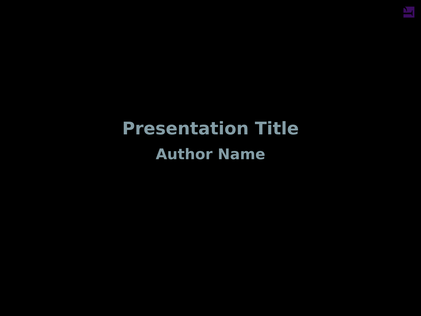
 Two overhead slides for a presentation. The slides use white on black for better contrast on most projectors, and a 4x3 aspect ratio. Download the PDF or the HTML and CSS.
Two overhead slides for a presentation. The slides use white on black for better contrast on most projectors, and a 4x3 aspect ratio. Download the PDF or the HTML and CSS.
It is necessary to force a page break when creating overhead slides. This can be done by placing the content for each slide in a <div class="slide"> and using break-before: page as shown below. This example shows other styling that may be required to create presentation slides.
CSS
@page {
size: 1280px 960px;
@bottom-left {
content: "Presentation Title";
}
@bottom-right {
content: counter(page);
}
background: black;
color: white;
font-family: DejaVu Sans, sans-serif;
font-size: 16pt;
margin: 96px;
}
@page:first {
@bottom-left { content: normal }
@bottom-right { content: normal }
}
div.centerpage {
/*
* Cause the content on these pages to begin part-way through
* the page. This is useful for a title page.
*/
margin-top: 33%;
}
body {
font-size: 28pt;
font-family: DejaVu Sans, sans-serif;
color: white;
}
div.slide {
break-before: page;
}
HTML
<div class="slide">
<h2>Slide Title</h2>
<p>
Lorem ipsum dolor sit amet, consectetur adipiscing elit, sed do
eiusmod tempor incididunt ut labore et dolore magna aliqua. Ut enim
ad minim veniam, quis nostrud exercitation ullamco laboris nisi ut
aliquip ex ea commodo consequat. Duis aute irure dolor in
reprehenderit in voluptate velit esse cillum dolore eu fugiat nulla
pariatur. Excepteur sint occaecat cupidatat non proident, sunt in
culpa qui officia deserunt mollit anim id est laborum.
</p>
</div>
The font-family and color properties are specified both in the @page and body rules, even though they're the same. This is required because the page regions are outside of the body and must be styled separately, likewise the content within body cannot be styled by the @page rule.
A rendered slide for this example is shown in Presentation slides example. The example has been adapted from slides (HTML+CSS) for a presentation about the Mercury programming language. This is part of our samples repository. You are encouraged to use samples from the repository and contribute your own.
So far we have discussed forcing a page break, however suppressing page breaks is also important. For example, it is poor style to have a page break between a header and the first paragraph of a section. Therefore, the default Prince stylesheet will use the break-after property to suppress page breaks immediately after headers:
h1, h2, h3, h4, h5, h6 {
break-after: avoid
}
If a heading occurs at the bottom of a page, it may be moved to the next page to keep it with the content that follows it, usually a paragraph.
Avoiding page breaks within an element is also important. For example, it is best to avoid breaks within a figure or table. This can be done with the break-inside property:
.figure, table {
break-inside: avoid
}
If the figure or table would have been split across two pages, it may be moved to the next page to keep it in one piece. An element longer than one page will still need to be split across multiple pages.
The break-inside property cannot be used to create forced page breaks; its only valid values are auto, and the inhibiting avoid, avoid-page and avoid-column.
These three properties can be applied to block-level elements, table rows and table row groups that occur within an in-flow element (ie. inside the normal flow of the document, not inside a float or an absolutely positioned block). Therefore the figure and table example only make sense when the figure or table is not floated.
Page breaks have similarities with column breaks - for further details, see Columns.
Page breaks and decoration
When a page (or column) break occurs within a box (such as a div) its bottom and top borders are cloned so that they also appear at the bottom of the first section and the top of the second section of the box. This is shown in the left of Box decoration break sample. This is the default but may be set with the box-decoration-break property, setting its value to clone.
Box decoration break sample
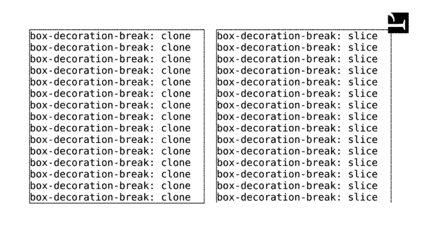 This figure shows the result of using the
This figure shows the result of using the box-decoration-break property. On the left the clone value is used while on the right slice is used. The PDF and HTML are available for download.
div.box1 {
box-decoration-break: clone
}
If instead you wish the borders to remain open, as if the box were simply sliced in half, as in the right of Box decoration break sample, then you can set this property to slice.
div.box2 {
box-decoration-break: slice
}
Widows and orphans
Just as breaking a page between a heading and the first paragraph below the heading can look bad, breaking the page after only one or two lines of a paragraph also looks bad. These stray lines are called orphans. The minimum number of orphans to allow can be specified with the orphans property (the default is 1).
p {
orphans: 2
}
Likewise the minimum number of lines to move to a new page (widows) can be specified with the widows property (the default is 1).
p {
widows: 2
}
It can be easy to confuse widows and orphans. However a mnemonic device can help: "An orphan is alone from the beginning [of the paragraph]; a widow is alone at the end [of the paragraph]". (Source Widows and orphans — Wikipedia).
Trimming marks
When typesetting a magazine or flier it can be useful to print right to the edge of the paper. However most printers will refuse do do this. It is better to print on larger stock and then crop the paper to the correct size. If you use the marks property, Prince will create bleed and trim areas around your content (and the declared page size). This can be seen in the catalog example, adapted from the Catalog sample in the Prince samples repository.
Furniture catalogue example
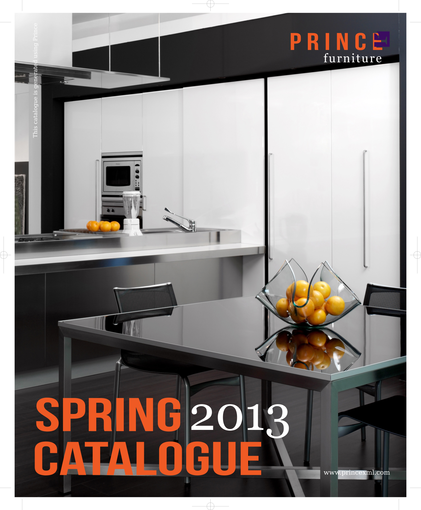 The furniture catalogue with bleed and trim areas for printing and cropping. Download the PDF or the HTML and CSS.
The furniture catalogue with bleed and trim areas for printing and cropping. Download the PDF or the HTML and CSS.
@page{
size: 8.5in 10.5in;
margin: 0;
background: url("images/CatalogueCover.jpg");
background-position: center;
background-size: 104%;
background-repeat: no-repeat;
marks: crop cross;
bleed: 0.25in;
-prince-trim: 0.25in;
}
This example uses some of the properties that we introduced above, plus three new ones: marks, bleed and -prince-trim. These options enable crop and cross marks and specify bleed and trim areas. Note that size of the content does not change when we add these options, the page is still 8.5in by 10.5in as specified by the size property. Instead 0.25in of bleed area and 0.25in of trim area has been added to each edge (1in total). Therefore we will need to print on 9.5in by 11.5in paper. Prince will print solid background colors and repeating pictures into the bleed area - we set the background size to 104% so that it would print into the bleed area.
Prince also allows the placement, length and width of the crop marks to be specified respectively with the -prince-mark-offset, -prince-mark-length and -prince-mark-width properties.
